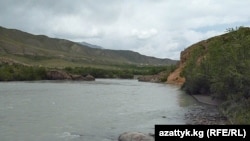
It has definitely been difficult for Kyrgyzstan to realize construction of the Upper Naryn Cascade hydropower project.
One complication after another has put the project on hold.
On July 10, information was posted on the Kyrgyz president's website that a Czech company had been found to construct at least part of the Naryn Cascade and several other smaller hydropower plants (HPP).
Celebrations were short-lived as, just a few days after the announcement, a scandal over the deal started in Kyrgyzstan and the Czech Republic that has become more confusing and aggravated with each day.
Since it is so confusing let's start with some information that is certain.
The plan for the Naryn Cascade project dates back to 1986, when Kyrgyzstan was a Soviet republic.
The project calls for the construction of four HPPs along the Naryn River, in the northern half of Kyrgyzstan, which flows westward eventually joining and providing badly needed refreshment to the Syr-Darya, one of Central Asia's two great rivers.
The four HPPs are – Akbulun with a planned capacity to generate some 87.4 megawatts (MW) of electricity, Naryn HPP-1 with a capacity of 47.7 MW, Naryn-2 with 47.6 MW, and Naryn-3 with 55 MW.
According to a Kyrgyz government presentation for investors in 2014, the total project should cost some $727.65 million.
The idea to construct the Naryn Cascade, and also the much larger Kambar-Ata-1 HPP (capacity 2,000 MW) along the Naryn River, came to nothing after the Soviet Union collapsed in late 1991.
Lack Of Funds
Kyrgyzstan has never had the funds needed to construct the Upper Naryn Cascade or Kambar-Ata-1, the latter with an estimated cost of some $3 billion.
In 2003 and 2004, Kazakhstan showed some interest in helping construct the HPP projects along the Naryn River (and the Rogun and Sangtuda HPP projects in Tajikistan) but that faded.
In late 2004, Russia started talking about the Naryn River projects and Russian company RusHydro (also seen as RosGidro) became Kyrgyzstan's partner in the project in the Upper Naryn Cascade project.
In early 2009, then-President Kurmanbek Bakiev announced Russia was providing Kyrgyzstan with a $450-million loan and would later extend an additional $1.7 billion for construction of Kambar-Ata-1.
Unfortunately, Bakiev's son Maksim, then in his early 30s, had been put in charge of Kyrgyzstan's economy and chose to use some of Russia's initial $450-million loan to invest in other projects.
The Kremlin quickly discovered the scheme and launched a soft-power attack on Bakiev using Russian television, which is widely available in Kyrgyzstan, particularly in the north.
Negative coverage of Bakiev on Russian television played a role in Bakiev's ouster in April 2010.
Plans for Kambar-Ata-1 and as a result, the Upper Naryn Cascade project, were put on hold again.
But Russia was back in 2011 and the Naryn River HPP projects seemed ready to advance.
Work did start but neither RusHydro nor RAO UES, which was the Russian partner in the Kambar-Ata-1 project, were enthusiastic about working in Kyrgyzstan, where the chances of showing a profit on their large investments was unlikely for possibly decades to come.
Falling Oil Prices, Sanctions
When Russia's economy started to suffer from falling oil and natural-gas prices and international sanctions imposed against Russia in response to the Kremlin's role in fighting in eastern Ukraine, RusHydro and RAO UES essentially stopped working on Naryn River HPP projects.
Kyrgyz President Almazbek Atambaev said at the end of 2015 that it was clear "our Russian friends would not be able to implement these projects" and, in January, Kyrgyzstan's parliament annulled the HPP agreements.
Again, the Upper Naryn Cascade project was suspended, and worse, Russia insisted that Kyrgyzstan owed $37 million for work that the Russian companies had done.
That brings us to July 10, and the announcement that Czech company Liglass Trading was prepared to pay the $37 million to Russia, effectively buying out RusHydro's shares in the Upper Naryn Cascade project, and build Akbulun and Naryn HPP-1.
The seemingly good news did not last long.
Already by July 14, the Czech news outlet Blesk.cz reported on July 14 that Liglass was an "unknown company with little turnover."
The report said in 2014 that Liglass "had sales of only 345,000 crowns (about $15,000) and the loss of 1 million crowns."
Bankruptcy Claims
Later reports in Czech and Kyrgyz media would claim Liglass was bankrupt in 2016.
Kyrgyz website 24.kg reported on July 17 that the Kyrgyz embassy in Austria had sought information about Liglass.
A March 10, 2017, letter from the embassy said that, despite claims on Liglass' website that it had implemented hydropower projects in Slovakia, Italy, Great Britain, and cooperated with China, "the Kyrgyz Republic's Embassy in Austria could not find any facts confirming the successful realization of [Liglass] investment projects abroad."
On July 18, Liglass representative Jiří Vojtěchovský offered assurances that the company was prepared to invest some $500 million in the Upper Naryn Cascade project.
On July 17, the Czech news-site Neovlivni.cz posted a September 8, 2016, letter purportedly from Vratislav Mynar, the head of the office of the Czech president, which says Liglass had "successfully finalized the project of construction of solar and hydroelectric power plants" and "is well-established not only to our Czech but also in the European market…"
Some reports say banks are prepared to help Liglass with financing of the Kyrgyz HPP project, other reports say banks turned down or never received any requests for financial help from Liglass.
The Czech newspaper Hospodarske Noviny provided RFE/RL's Kyrgyz Service with photographs of Liglass's main office in Železny Brod which do not inspire much confidence in the company's financial state.
The chairman of Kyrgyzstan's State Committee for Industry, Energy, and Exploration, Duyshenbek Zilaliev, said on July 17 that Liglass has 50 days to start fulfilling its financial obligations or the deal with the Czech company will be scrapped.
Zilaliev also called for an end to the hysteria that is already surrounding this deal.
Whatever the outcome of this latest development, it is another example that construction of the Upper Naryn Cascade project, which is an important project for Kyrgyzstan, seems fated to be accompanied by complications.










